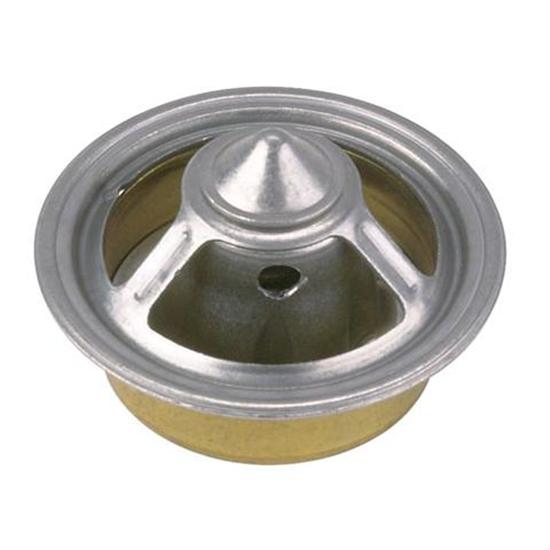| Before
beginning this discussion, a disclaimer: I have little experience with
and no interest in Ford motors. The reason this chapter is here is that
the Robertshaw thermostat is occasionally discussed as a replacement for
sleeve bypass applications in early Jaguars. They can't function for bypass
control in Jags because they really aren't sleeve bypass thermostats, but
they are still occasionally of interest because they are very high flow.
In the process of assembling information on Robertshaw thermostats for Jaguar use, I've come across quite a bit of information about Ford cooling systems. It seemed reasonable to deposit that information here, and maybe dispel some of the mythology that has grown up around this particular design. But mostly it's here because I admire the clever design, which has the advantages if high flow, balanced force, simplicity, and low cost to manufacture.
This design is of relatively recent origin. It was patented 1957 by Louis Puster of Sylphon-Fulton, which at the time was the parent company of Robertshaw (US patent 2872117). For many years it was manufactured and sold under the Robertshaw brand name. For this reason, it's known as a Robertshaw thermostat, although current applications may be supplied by other companies. If you say "Robertshaw thermostat", people will generally know what you are talking about. It was used for many production vehicles from Ford, AMC and AM General, and is most frequently discussed in the context of the Ford 351 Cleveland engine. Today, Robertshaw style thermostats are available from several US, Chinese and Australian labels (but not Robertshaw, which no longer sells direct to consumer).
The surprising thing about this thermostat is that it's a controlled bypass design in it's native applications, although it appears otherwise at first glance. When open, the wax capsule doubles as a poppet valve and nestles into the bypass port. Unlike the more common dual poppet thermostat, the bypass valve height isn't self adjusting, and so the dimensions of the wax capsule are critical to making a sufficiently tight seal. In fact, all of the dimensions are critical, including the travel distance of the wax motor. This can pose a challenge to keeping the system working properly. Because
the thermostat is located between left and right transverse flows, a local
area of high static pressure is created above the bypass. This will force
hot coolant through the bypass if there's any leakage at all. A less critical
problem is that the entire poppet cylinder seals against the bypass plate.
In this position, there's limited circulation of coolant around the wax
capsule, making the system less responsive at extreme temperature. It's
no wonder there is so much discussion about bypasses and thermostats in
the Ford world.
 Several
design features make this thermostat unique. First, the return spring is
housed in a central pylon, which is welded to the top flange. The poppet
is a "can" rather than a flat plate, and has a huge 1 9/16 inch diameter.
The reason that the bottom of the "can" is punctured is to allow dynamic
pressure to balance on both sides of the poppet. This reduces the force
necessary to open the thermostat and prevents lifting in high flow
conditions, a unique advantage of the design. The O-ring seals the poppet
against the central pylon: it can deteriorate and allow coolant to leak
past the thermostat. If you have difficulty holding temperature, this ring
may be worn out. The only fix is to replace the entire thermostat.
These
thermostats often have a copper hat or lip attached to the wax capsule,
and this acts as the actual bypass valve. The hat has to be sized to closely
match the diameter of the bypass passage. For the 351C, there is a removable
"water bypass plate" (that's the correct term: not a restrictor, not a
washer), which must be matched the thermostat being used. There are other
Ford engines where the bypass port is cast in place, and can't be changed.
But whatever application you deal with, your thermostat has to match your
bypass opening. If the hat is too big, the thermostat will tear itself
apart on the restrictor plate. If it's too small, it won't fully block
the bypass and the engine may run hot.
Let me add a few words here about blocking the bypass. I understand that the design has its problems, and that there are a few documented mods for blocking off the bypass. These include soldering a penny to the bypass plate! Keep in mind that the bypass is there to promote faster warm up and to maintain continuous flow of coolant around the block. However, I understand that the reality of things is sometimes different than design theory. So you may find that permanently plugging the passage is the expedient solution to a persistently troublesome system. If you are inclined to do this, there are three things you must keep in mind: First, you need to allow air to bleed through the bypass plate, or you will have trouble with the initial coolant fill. So a tiny hole in your plug will be necessary. Second, you need to allow enough room for the thermostat to move backwards as it opens. Because of this, the plug has to be below the bottom of the bypass plate: a custom plate may be required (there is an E-Bay vendor selling custom plates). Finally, you need to provide for some coolant circulation when the thermostat is closed. The reason for this is that hot spots form when coolant can't circulate. Even if the coolant doesn't boil, extreme damage can be done to the engine by uneven heating. So you will need to drill the pylon of your thermostat, or use Stewart 300 or 301, which are pre drilled.  
Copyright©2020 CoolCat Express Corp <S1
E-Type 4.2
Main
S2 E-Type 4.2>
|







